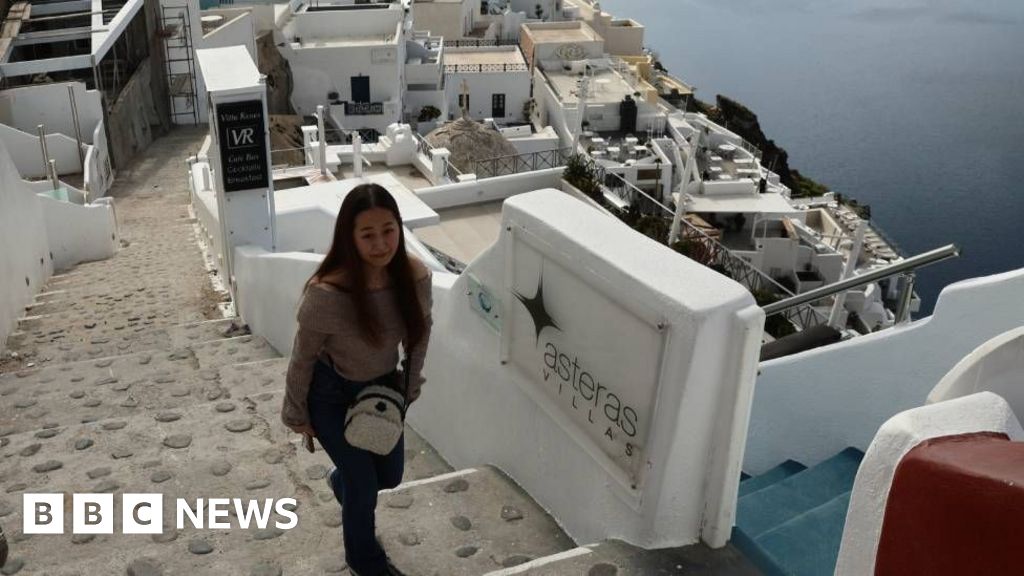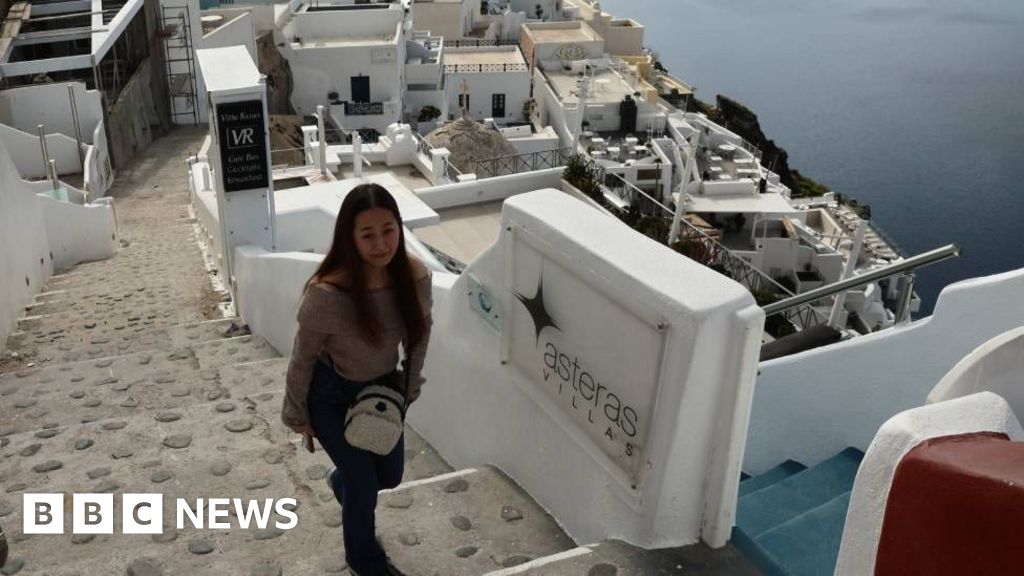
Thousands of residents are fleeing Santorini after hundreds of earthquakes were recorded near the Greek island in the last 48 hours.
About 9,000 people have left the island since Sunday, with additional emergency flights scheduled to leave on Tuesday.
More than 300 earthquakes have been recorded in the past two days near the island, and some experts say tremors could continue for weeks. Authorities have closed schools and warned against large indoor gatherings, but Prime Minister Kyriakos Mitsotakis has urged calm.
Santorini is a popular tourist destination but most of those leaving are locals, as February is outside the peak tourist season.
Dozens of tremors have been recorded in the Aegean Sea north-east of Santorini so far on Tuesday, with a large earthquake measuring magnitude 5 striking mid-afternoon.
Several days of continuous seismic activity has led some residents to sleep in their cars – afraid to spend the night in their homes in case walls or ceilings cave in.
No major damage has been reported on the island so far, but emergency measures are being taken as a precaution.
Hundreds of people queued at a port in the early hours of Tuesday morning to board a ferry leaving for the mainland.
“Everything is closed. No-one works now. The whole island has emptied,” an 18-year-old local resident told Reuters news agency before boarding the vessel.
Local media reports around 6,000 people have left the island by ferry since Sunday, and a further 2,500 to 2,700 passengers will have flown from Santorini to Athens via plane on Monday and Tuesday, according to Aegean Airlines.
The carrier said it had added nine emergency flights to its schedule following a request from the Ministry of Climate Crisis and Civil Protection.
In recent days, an estimated 9,000 people in total have fled Santorini – a small island with a population of just 15,500.
The island welcomes millions of tourists annually, but bookings this time of year are minimal, so local residents and workers make up the majority of evacuees.
Kostas Sakavaras, a tour guide who has lived on Santorini for 18 years, left the island with his wife and children on Monday.
“We considered it’s a better choice to come to the mainland as a precaution,” he told BBC News.
“Nothing has been falling, or anything like that,” he said, adding that the worst part had been the sound. “That’s the most scary part of it,” said Mr Sakavaras, who plans to return home once schools reopen.
Schools are scheduled to stay closed on the island until Friday. Authorities have also warned people to avoid certain areas of the island and empty their swimming pools.
Santorini’s Mayor, Nikos Zorzos, said the island was prepared for seismic activity that “may last many weeks”. The island must approach it “with patience and calm”, he said on Tuesday.
He added that plans were in place to build shelters and provide food for the population should larger tremors emerge.
On Tuesday morning, representatives from the government, armed forces and emergency services met at the Ministry of Climate Crisis and Civil Protection to discuss the situation.
The prime minister will chair a similar meeting on Wednesday.
Prime Minister Mitsotakis said on Monday that Greece was working to manage “a very intense geological phenomenon”.
Seismologists consider the recent tremors to be minor, but preventative measures have been put in place in case a larger quake occurs.
Emergency services have warned residents to leave the areas of Ammoudi, Armeni and the Old Port of Fira due to landslides.
The South Aegean Regional Fire Department has been placed on general alert and rescue teams have been dispatched, with crews standing watch by large yellow medical tents on the island.
Concern remains high over the hundreds of earthquakes in the region of the Greek Cyclades Islands, with scientists rapidly analysing data to better understand the phenomenon.
Most of the strongest earthquakes are originating from an area around the tiny islet of Anydros, north-east of Santorini.
With seismic activity remaining intense in the region, scientists are on alert not only for Santorini, but also for Amorgos, Anafi and Ios.
In the event of a larger earthquake, the main issue is the resistance of buildings, especially in Santorini, due to the peculiarities of the soil.
Santorini is on what is known as the Hellenic Volcanic Arc – a chain of islands created by volcanoes – but the last major eruption was in the 1950s.
Greek authorities have said that the recent tremors were related to tectonic plate movements instead of volcanic activity.
Scientists cannot currently predict the exact timing, size or location of earthquakes.
But there are areas of the world where they are more likely to occur which helps governments to prepare.
Earthquakes occur as the result of tectonic plates moving either past, below each other or apart. This results in stress that is built up and then released as earthquakes along or near the boundaries of these plates – known as fault lines. Santorini and the Greek Islands are near such a line.
As scientists cannot predict such events, the best way to prevent damage or loss of life is for authorities to reduce the vulnerability of their populations. This can be through designing and constructing earthquake-resistant buildings or evacuating residents when earthquakes begin.



